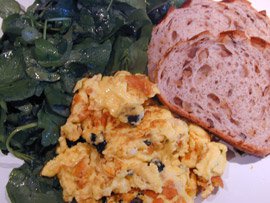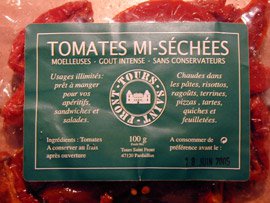
[Truffled Scrambled Eggs]
The other day at lunchtime, I was on my own and starving. A glance in the fridge, and lunch rolled out before my eyes : I had one truffle left in its little jar, some eggs, fresh watercress, and fabulous walnut bread from the BoulangEpicier, which Patricia, the best neighbor in the whole wide world, had bought for me on her way home from work.
Upon closer inspection, the top of the truffle had grown a delicate little beard, white and fuzzy. I hesitated for a second, then thought well, aren’t truffles a type of fungus in the first place? A little more wouldn’t hurt, would it? And how often do I have truffles, bearded or otherwise, in the fridge?
I cut off the top and put the incident behind me.
I whipped up the brouillade (the name derives from “brouillé”, which means “scrambled”), rinsed and seasoned the watercress, toasted the bread, and arranged all this on a plate. I sat myself comfortably at the bar, and enjoyed my classy lunch, while leafing idly through the April issue of Gourmet Magazine, which my friend Nassim kindly brought back from his recent trip to NY.
Alternate name for the recipe : “How to feel like a superstar“.







